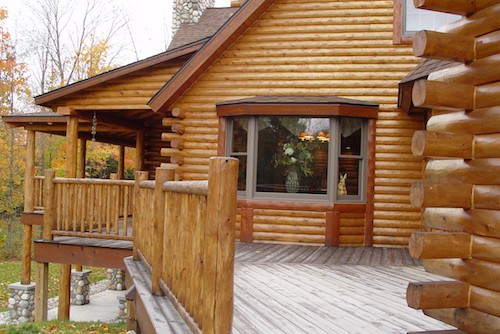Protect the Walls of Your Log Home
 The walls of your log or timber frame home wrap you with protection. They keep you safe from the elements and harmful UV rays. They keep you warm in the winter and help you stay cool during summer. All the while, your walls bear the brunt of all that Mother Nature has to throw at them.
The walls of your log or timber frame home wrap you with protection. They keep you safe from the elements and harmful UV rays. They keep you warm in the winter and help you stay cool during summer. All the while, your walls bear the brunt of all that Mother Nature has to throw at them.
Luckily, there are simple steps you can take to protect the walls of your log home. It all starts with smart design and ends with regular maintenance.
What causes damage to the walls of a log home?
Wood isn’t engineered to be invincible. It’s strong and sturdy, but it’s also natural; therefore, it’s subject to natural threats that can break it down and create vulnerability. Some of its biggest enemies include:
• UV rays
• Excessive moisture
• Weather, including high wind and heavy rain, snow and hail
• Wood-boring pests
How do you protect the walls of your log home?
1. Begin with a strategic blueprint.
There are design decisions you can make to protect your exterior walls from the ground up. First, orient your home on the building site to limit exposure to harsh sunlight, or make a plan to create extra shade on the sides of your home that receive the most direct rays.
It’s also important to keep wood siding as far off the ground as possible. Talk to your builder about different facades you can mix with wood siding that complement the natural aesthetic of a log home. Field stone or river rock are great options.
Longer eaves or covered porches act like ball caps on your roof. Incorporate these into your home design to create shade and stop moisture from soaking exterior walls.
2. Build in protection.
You can protect wood walls as soon as construction begins. Start by selecting the right wood. Northern White Cedar log siding is a hardy option. It’s durable and tough, naturally impervious to damaging insects with built-in weather resistance.
Before you begin erecting walls, pretreat the wood for extra protection. Use log solution to remove mill glaze and other grime that adhered to the log siding during transport. Once the siding is thoroughly rinsed and dried, apply a borate preservative to deter destructive pests and decay.
Finish your constructed walls with an exterior stain and sealant as a final layer of protection. When choosing a stain, find one that shields walls against UV rays. As a rule of thumb, the darker the stain pigment, the stronger the protection.
3. Perform regular maintenance.
Every year, schedule time to wash the exterior walls of your log home. During this time, keep a sharp eye out for flaking or peeling stain and fungus. Also look for checking and cracking in the wood that can lead to moisture problems. Finally, carefully inspect chinking between log posts to make sure the seals aren’t compromised. Take time to touch up, repair or replace any issues before they become major problems. Get more advice for maintaining your log home, here.

Don’t Forget About Interior Walls
There also are steps you can take to protect the White Cedar, White Pine or Beadboard paneling hanging on the interior walls in your home. One of the hallmarks of log cabin design are expansive windows. While beautiful, they let in sunlight that can damage and discolor walls. Select windows with low-e glass or a protective coating to help block rays without compromising views.
Because wood naturally expands and contracts, your builder shouldn’t install wall paneling the moment the shipment arrives. Make sure your builder lets the wood acclimate first, and then apply a protective stain once it’s installed. In wet areas, such as kitchens and bathrooms, consider brushing on a clear polyurethane for added repellency.
At Heartwood Mills, we strive to provide quality wood products that will stand the test of time. Talk to our experts about what you can do to keep the walls of your log or timber frame home strong.
